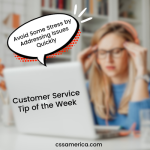About 1/3rd of the most memorable customer service encounters in government are negative. Does that number seem low? Well keep in mind that the statistic was taken from a survey of employees of Federal, State, and Local governments, and even the sub-50% number from employees still isn’t positive.
But this GovLoop survey was more focused on the future than the past. And many of these employees are optimistic about the future because of some key trends they see developing including “Self-service opportunities, from grocery store kiosks to online applications, will allow citizens to access, process and monitor their government requests on a more widespread and frequent basis. Citizen engagement and partnership efforts that empower citizens will also become more prevalent. Mobile applications, increased social media interactions and the expansion of live, online chats also will radically change the way government delivers services in the next five to ten years.”
So these are the trends to anticipate, and the question becomes, What does this mean to the typical local government or employee? Here are three key takeaways:
- Here Comes Proliferation. More service channels for the taxpayer mean more complexity, more need to monitor standardization of information and the experience, more staff training, and more metrics to gauge and improve performance. More, more, more infrastructure, training, and monitoring.
- Calling All Techies! Tech-savvy employees will be a requirement, not a nice-to-have, and most local governments won’t be able to have separate divisions/departments dedicated to separate service channels because staffing is too small. Therefore, many staff will have to learn to be jacks-of-all-trades (responding to e-mail requests, social media complaints, calls, web issues, and potentially onsite visits – all in the same day).
- Teach the Citizens Well. “Self-Service” means that the customer can do for themselves. This requires a mindset and intentional planning and work to train citizens on how to do for themselves. It’s the proverbial teach them to fish, but the fish they’re catching is information, or a recycle bin, or compost, or an inspection, or a tax payment, or a reservation at a park shelter. For Self-Service to succeed, we need to serve as a teacher to inform, educate on what they can do and how to do it.
With variety comes complexity, and with a greater tech emphasis comes the search for people who can blend a technology skill set and a customer service mindset.
Get ready for the future of government customer service.
Did you like this post? Here are other Government-related posts:





















